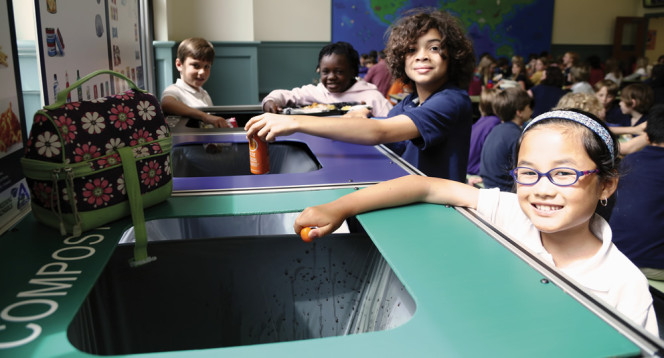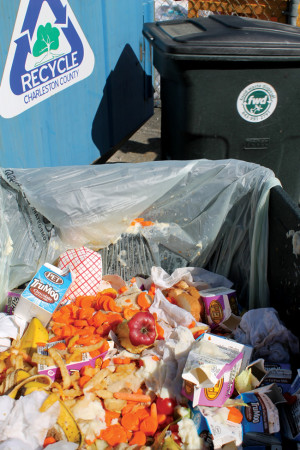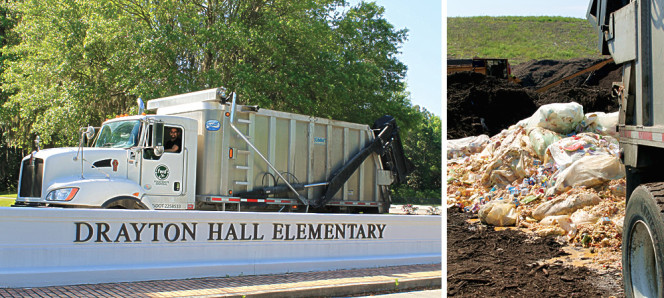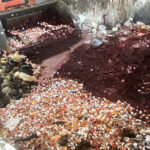Beginning with the youngest, more and more residents are learning to source separate organics in Charleston County, South Carolina.
Nate Clark
BioCycle May 2014
 In June 2012, Bee’s Ferry Compost Facility, Charleston County, South Carolina’s municipally owned and operated leaf and yard trimmings composting facility, received an operating permit to process pre and postconsumer food waste following a 12-month pilot (see “Charleston County Fosters Food Waste Composting,” January 2013). With this newfound option for managing food waste, businesses and institutions across the county began implementing diversion programs. Among them was the Charleston County School District, where officials implemented a pilot program in 11 school cafeterias during the 2012-2013 school year, to capture the food scraps students discard during their lunch periods. Proving successful from a social, economic, and environmental standpoint, the Charleston County School Board made the pilot a district-wide program in the beginning of the 2013-2014 school year.
In June 2012, Bee’s Ferry Compost Facility, Charleston County, South Carolina’s municipally owned and operated leaf and yard trimmings composting facility, received an operating permit to process pre and postconsumer food waste following a 12-month pilot (see “Charleston County Fosters Food Waste Composting,” January 2013). With this newfound option for managing food waste, businesses and institutions across the county began implementing diversion programs. Among them was the Charleston County School District, where officials implemented a pilot program in 11 school cafeterias during the 2012-2013 school year, to capture the food scraps students discard during their lunch periods. Proving successful from a social, economic, and environmental standpoint, the Charleston County School Board made the pilot a district-wide program in the beginning of the 2013-2014 school year.
Charleston County School District is made up of 76 schools, and eight additional charter schools. Of the 84 schools, 32 are participating in food scraps diversion programs. The majority (28 of 32) are elementary schools, part of a deliberate strategy by program implementers. “We wanted to get students off to a good start at an early age, and get them used to source separation of trash, recycling, and food scraps being part of the school day,” notes Maggie Dangerfield, Sustainability Coordinator for Charleston County School District. “This way students can learn source separation skills early on, and keep with that behavior as they progress to middle and high school.”
Another reason for initiating diversion programs at elementary schools first is the lunch menu. “At all elementary schools, lunch menus are consistent,” states Bronwyn Santos, Greening Schools Coordinator with the Charleston County Environmental Management office. “Conversely, at the middle and high school levels, there is lots of diversity for food options, and thus lots of diversity in what will be thrown away. For this reason, more training is required on what is compostable and what is not. For example, some schools have outside vendors that sell food packaged in material that is paper, foil, and plastic. This will be an issue in the high schools.”
Despite beginning diversion programs with the youngest students first, both Dangerfield and Santos note that age has not played much of a factor when it comes to adaptation of source separation behaviors and success of diversion programs. “In terms of performance, for instance, middle school students may pick up source separation quicker, but might not follow through as much,” notes Dangerfield. “Conversely, elementary school students may not pick up the behavior as quickly, but might have more follow through once they learn. It just depends. There is a lot of variation in reasons for good or poor participation, including where collection bins are placed and how well bins are monitored.” Santos agrees: “Younger children are more accepting of source separation. The older students, who are becoming more socially conscious, are more likely to disengage themselves from the process as behavioral compliance becomes less rewarding for some of them. Younger students want to please, and will do what they are told — school is still new and exciting, and praise for properly sorting their waste is very rewarding for them.”

The program is designed to capture postconsumer food scraps from school cafeterias, although a few schools also include preconsumer material from their kitchens.
Photo courtesy of Food Waste Disposal
Collection Logistics
The food scraps diversion program within the Charleston County School District is designed to capture postconsumer food scraps from school cafeterias. A few schools, however, divert preconsumer food waste from their kitchen through the program. Wayne Koeckeritz, owner of Food Waste Disposal, a Charleston County-based food scraps hauler contracted by the school district to service the schools, notes that most of what he sees in the collection bins is prepared, “heat and eat” type foods. “We also get all the foodstuffs that students bring to school but don’t eat — lots of uneaten sandwiches.” According to Santos, any food item, including meat and bones [meat must be cooked] is accepted in the compostables collection bins, as well as paper napkins and milk cartons.
Koeckeritz provides 64-gallon roll carts for collection and storage of food scraps, as well as EcoSafe compostable liners to keep carts clean and reduce residuals that remain in the carts after they are emptied, a provision in his contract with the school district. Koeckeritz explains that at many schools, he will take out the full liner and replace it with a new one, secured with a rubber band. But at other schools, the day porter(s) [custodial staff] prefers he not replace the liner right away. “Some schools prefer to have the opportunity to rinse out carts after I service them, in case of spillage,” he says. “If that is the case, I will tie a compostable liner onto the handle of the cart, and the day porter will reline the cart once it is rinsed. Linings help cut down on residuals, but it is not a foolproof way to keep carts clean — no garbage bag is.” The EcoSafe liners are accepted and composted at the Bee’s Ferry facility.
Koeckeritz notes that although contaminants do find their way to the compostables bins, contamination issues are similar to those he experiences with any customer, and are not unique to the school program. “No doubt there is a challenge within schools to get them to reduce or eliminate Styrofoam, but thanks to the really great source separation training program that Bronwyn Santos and Maggie Dangerfield have developed, contamination has not been a major issue,” he says. All food scraps from the district schools are hauled to the Bee’s Ferry Compost Facility, located in the same area as the county landfill. Some schools within the district receive finished compost to use as a soil amendment in school gardens, further exhibiting the closed loop nature of composting as a waste management option to students.
A key element in the success of the Charleston County food scraps diversion program is the “digital education toolkit” developed to introduce the program, and its relevance, to administrative staff, school faculty and the student body. Before a program is implemented at a school, Dangerfield and Santos meet with the principal, the school’s “green liaison” (100 teachers within the school district are “sustainability” liaisons, responsible for communicating directly with Dangerfield), the school’s day porter, and any other interested staff, to review program logistics, the “digital education toolkit,” and address any questions or concerns.
“The ‘digital education toolkit’ includes a PowerPoint, a SmartBoard game, and other instructional resources that explain what source separation is, how to do it, and why the practice is important, e.g., socially, environmentally, etc.,” Dangerfield explains. “In general we give out the same educational preparation materials, but there is a degree of ‘to each its own’ when it comes to program implementation, mainly with the placement of collection totes, figuring out how much monitoring is necessary, or how to integrate the source separation knowledge throughout the school. For example, depending on the number of students within a school, some administrators decide to hold an assembly and teach all students at once, while others find it more effective to use library or classroom time.”

The majority of schools currently participating (28 of 32) in the program are elementary schools (above). All food scraps are hauled to Charleston County’s Bees Ferry Compost Facility (right), which was permitted in 2012 to receive pre and postconsumer food waste.
District-Wide Savings
All Charleston County landfill fees (recycling is picked up by county) are based on a “user-fee,” meaning that every year, businesses and institutions (such as schools) pay an additional cost on their property taxes based on the number of dumpsters they have and the frequency those dumpsters are serviced each week. Single-family residents pay a set $99/year. In Charleston County, the majority of businesses and institutions have at least one 8 cubic yard dumpster serviced 3 to 5 times per week. According to Santos, for every day that the frequency of trash being picked up from one school is reduced per week (i.e. from 3 to 2 times/week), the school district saves $1,300/year on landfill fees from that school.
These financial savings were a large motivator for school board officials adopting the food scraps pilot as a school district wide program. But school board support doesn’t directly translate to program success; administration and faculty play an important role in promoting and being champions of the diversion programs at their respective schools. “Variation in the adaptability to source separation occurs depending on how much the diversion program has been championed within that school,” Dangerfield explains. She is confident that as the “model” schools, or champions of the program, within the district share their strategies and successes, it won’t be long until the other schools realize source separation is not as ominous as it seems. “Any program that is an addition to the general schedule of the school day needs to be championed — that championing of it by whatever individuals affects how well it is performed,” she says.
As the 2013-2014 academic year comes to a close, program implementers are excited with the successes they have seen, and plan to continue to expand food scraps diversion programs to more schools over the next year. “The program is a triple bottom line winner, great educationally, economically and environmentally,” adds Dangerfield. “It cuts down on trash hauling and landfill user fees because less is going into the dumpster, and instead, we are taking what was once considered waste and repurposing the nutrients within it. Those cost savings are how we have been able to afford the programs, while also capturing the benefits of being environmentally friendly — I really think it is a win-win.”
The district’s diversion rates speak to that success. From September 2013 to March 2014, the 32 participating schools diverted 294 tons of food scraps from the landfill — about 32 pounds diverted per student. Eighteen schools will be added over 2014-2015, which will mean nearly all of the elementary schools and most middle schools will be source separating trash, recycling, and compostables.
But for Santos, Dangerfield and Koeckeritz, the real rewards come from outside of the school system. “Food Waste Disposal collects food scraps from a number of businesses and institutions in the county, including the three Charleston County water parks,” explains Koeckeritz. “On multiple occasions, I have heard stories of students that go there and educate their parents on how to properly source separate their waste. These kids have been source separating for nine months or more, so when they go to the water park and see the sorting stations, they already get it and educate their parents on the proper behavior. It is stories like these that make all the work worthwhile.













